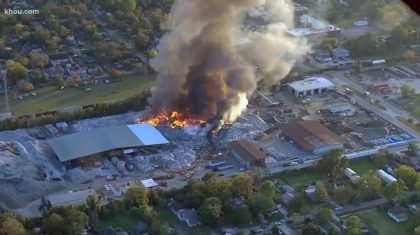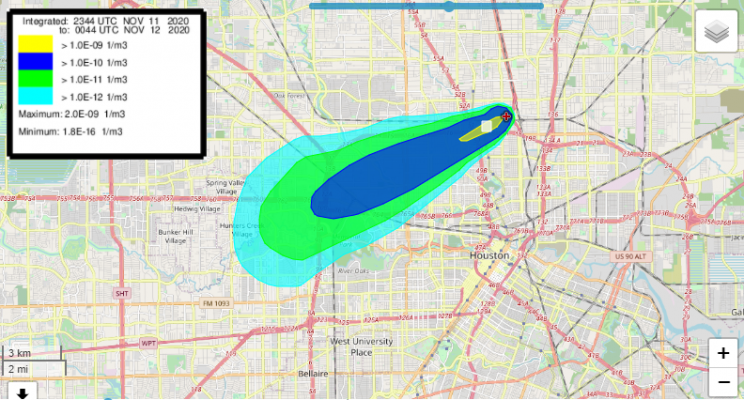ARL Weekly News – November 13, 2020
| Recent Events |
Usability Improvements to HYSPLIT for Specific Location Data

Arial view of November 11, 2020 recycling plant fire in Houston, Texas. (Image courtesy of KHOU).
When fire broke out at the Independent Texas Recyclers on November 11, in Houston, Texas, local Fire and HAZMAT crews were dispatched to respond. Pungent black smoke poured from the fire along with potential toxins. A shelter in place order was issued for Northeast Houston as HAZMAT monitored the air and water; anyone within a half mile radius was advised to stay inside with windows closed as teams battled the blaze. The acrid smell had already alerted residents to the seriousness of the situation. The Houston/Galveston Weather Field Office (WFO) knew the origin of the fire, but information about the structures, proximity to homes, and terrain was critical to respond in the most efficient manner.
“Unfortunately, these types of events occur on a fairly routine basis here” according to Brian Kyle of the Houston WFO. However, there are other “larger and more concerning refinery and chemical plant releases and hazmat events,” and knowledge of the contents of the plant would better inform not only the approach of the responders, but also the issuance of public health alerts.
However, there are new tools to help them locate the source and content of industrial smoke plumes. Several usability improvements to HYSPLIT have been incorporated. These improvements expand on the ability to use HYSPLIT simulations to enable precise and quick reaction by local response agencies. The HYSPLIT interface has more tools to determine location and terrain information, and include multiple navigation means such as location or street address. New options for satellite views, with an option for MODIS/VIIRS satellite imagery, is also available to identify specific industrial structures and equipment as well as potential runoff problems. Also in progress is a cloud option that is being tested by NOAA Web Operation Center (WOC) and ARL that will allow 24/7 access to all WFO’s. Initially suggested by the Houston WFO, these interface changes are available at the ARL development site: https://www.ready.noaa.gov/hysplitcameodev/.

HYSPLIT Atmospheric Dispersion predictions from for Nov 11, 2020, northeast Houston area smoke plume. The WFO provided these information to the Houston Office of Emergency Management to inform the public alerts and response options.
| Recent Presentations |
Design Review Held for National Air Quality Forecasting Capability Revisions
ARL/NWS held a Design Review for the National Air Quality Forecasting Capability (NAQFC) the week of November 9. Ariel Stein and Rick Saylor were among the dozens of government laboratory and institution directors and review panelists providing NAQFC developers with assessments and proposed future direction for the program.
ARL’s team proposed substantial improvements to the NAQFC scheduled to be implemented in 2022. This proposed redesign of the NAQFC incorporates major component upgrades or changes, including:
(1) Meteorology updated from regional North American Model (NAM) to Global Forecasting System (GFS),
(2) Deployed NOAA-ARL-Chemistry-Coupler (NACC) interface between meteorology and atmospheric composition models,
(3) Upgraded dynamic chemical lateral boundary condition (CLBC) to use the newly NWS operational global aerosol forecast for dust and smoke particles,
(4) Upgraded anthropogenic National Emission Inventory (NEI) based US EPA 2014 data to 2016 data;
(5a) Upgraded intermittent natural emissions for wild fires using the newly released National Environment Satellite, Data, and Information Services (NESDIS) global Biomass Burning Emission Product (GBBEPx) for pollutant and heat fluxes, and
(5b) Upgraded natural wind-blown dust using ARL’s Fengsha module developed by Daniel Tong and Barry Baker, and
(6) Upgraded the Chemical Transport Model (CTM) from the US EPA Community Air Quality Multi-scale Model (CMAQ) version 5.0.2 to version 5.3.1. This revision improves both Ozone and Particulate Matter (PM) forecasting by incorporating new science for volatile organic carbon, halogen, and PM species.
ARL Researchers contributing to this bundle of processing upgrades for NAQFC include: Drs. Daniel Tong and Barry Baker for emission work; Dr. Patrick Campbell for NACC and result evaluations; Dr. Youhua Tang for GBBEPx and CLBC; and Dr. Pius Lee for coordination of the various upgrades as well as presentation. The review team was convened to improve the NAQFC and further the aims of providing a vital health-protection forecasting service that includes the latest detailed atmospheric composition information for weather and climate feedback.
Future developments include using geostationary satellite data to rapidly update inputs to the NAQFC and incorporating of current science for sub-seasonal and seasonal interoperable earth model development to fulfill NWS needs for emission forecasting, wildfire modeling, and surface-atmosphere interchange understanding.
ARL Briefing to NOAA’s Quantitative Observing System Assessment Program
Dr. Tianfeng Chai gave a presentation at NOAA Quantitative Observing System Assessment Program (QOSAP) monthly meeting on November 12 on “Atmospheric Sciences Modeling at NOAA Air Resources Laboratory (ARL).” His talk focused on HYSPLIT inverse modeling work. The QOSAP seeks to maximize the data return from its observational systems in a cost efficient manner.

